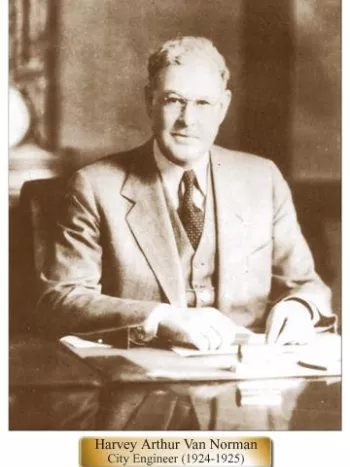
Harvey Arthur Van Norman was born in Victoria, Texas on October 5, 1878. At the age of five, with his parents, three sisters and two brothers, he crossed the plains of Texas to California where the family settled in Santa Ana. In 1887, he moved to Los Angeles where he was to spend the rest of his life.
He attended public schools in Los Angeles and secured a technical education through home study courses coupled with practical experience.
Mr. Van Norman succeeded William Mulholland as Chief Engineer and General Manager of the Bureau of Water Works and Supply when Mr. Mulholland retired on November 12, 1929, holding that post until his appointment as General Manager and Chief Engineer of the entire Department when the separate water and power bureaus were merged into a single organization on November 1, 1943.
He originally joined the Department forces in 1907, when be resigned as superintendent of construction for the Los Angeles Gas and Electric Corporation to become superintendent of two divisions of the Los Angeles aqueduct. Following completion of that project, Mr. Van Norman became Aqueduct Engineer in charge of operation and maintenance.
In 1924, at the behest of the Board of Public Works, he was placed in charge of construction of the north outfall sewer, completing the project in May, 1943 for $7,000,000, a saving to the city of some $5,000,000. The following year he was appointed City Engineer, returning to the Department at the request of the Board of Water and Power Commissioners in August, 1925, as Assistant Engineer of Water Works and Supply, continuing in that capacity until he assumed the responsibilities of his chief and close friend upon Mulholland's retirement.
Outstanding projects completed under Mr. Van Norman's direct supervision as head of the water system included the Mono Basin project, diverting the waters of five streams into the Owens River watershed through an 11-mile tunnel under the Mono Craters, augmenting the Aqueduct supply by some 40 percent, construction of Boquet Dam and Reservoir together with 18,500 feet of pipeline connecting it with the penstocks leading to powerhouse No. I in San Francisquito Canyon, and the interconnection between the Colorado River Aqueduct and the local water system.
During the first World War, Mr. Van Norman was commissioned as Captain of Engineers in the United States Army. He was a member and past president of the Los Angeles section of the American Society of Civil Engineers and of the California section of the American Waterworks Association. He died on January 16, 1954.
During his service as City Engineer, City population reached 1,000,000; 43,000 of whom were real estate agents. The town appropriated $2,500,000 for street improvements and 150 miles of new streets were paved.